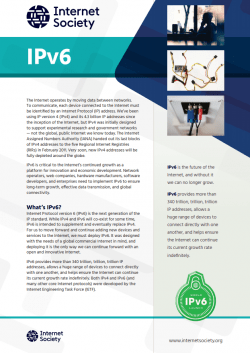The Internet operates by moving data between networks. To communicate, each device connected to the Internet must be identified by an Internet Protocol (IP) address. We’ve been using IP version 4 (IPv4) and its 4.3 billion IP addresses since the inception of the Internet, but IPv4 was initially designed to support experimental research and government networks — not the global, public Internet we know today. The Internet Assigned Numbers Authority (IANA) handed out its last blocks of IPv4 addresses to the five Regional Internet Registries (RIRs) in February 2011. Very soon, new IPv4 addresses will be fully depleted around the globe.
IPv6 is critical to the Internet’s continued growth as a platform for innovation and economic development. Network operators, web companies, hardware manufacturers, software developers, and enterprises need to implement IPv6 to ensure long-term growth, effective data transmission, and global connectivity.
What’s IPv6?
Internet Protocol version 6 (IPv6) is the next generation of the IP standard. While IPv4 and IPv6 will co-exist for some time, IPv6 is intended to supplement and eventually replace IPv4. For us to move forward and continue adding new devices and services to the Internet, we must deploy IPv6. It was designed with the needs of a global commercial Internet in mind, and deploying it is the only way we can continue forward with an open and innovative Internet.
IPv6 provides more than 340 trillion, trillion, trillion IP addresses, allows a huge range of devices to connect directly with one another, and helps ensure the Internet can continue its current growth rate indefinitely. Both IPv4 and IPv6 (and many other core Internet protocols) were developed by the Internet Engineering Task Force (IETF).
So What?
IPv6 is the future of the Internet, and without it we can no longer grow.
IPv6 has been in use since 1996, but real-world deployment has been slower than anticipated. To some, IPv6 might not seem immediately necessary. After all, most of your applications still work and your experience on the Internet has stayed mostly the same. But this is starting to change. Some major applications already fail to work when IPv6 is not available and there is a lack of IPv4 addresses. A lack of IP addresses means that:
- Your favorite Internet programs, online games, and applications could slow down or stop working.
- Internet-connected devices have a harder time communicating with each other, making the ability to offer services like voice and video difficult.
- Internet reliability and transparency could be compromised due to shared IPv4 addresses.
- New devices, appliances, sensors, and other objects (often referred to as the “Internet of Things”) will be unable to connect or will have difficulty communicating.
Do Your Part: Deploy IPv6.
In 2012, the Internet Society convened World IPv6 Launch, where major Internet Service Providers (ISPs), home networking equipment manufacturers, and Web companies around the world came together to permanently enable IPv6 for their products and services. IPv6 usage has increased exponentially since then. For example, nearly 25% of users on Google services are using IPv6; nearly 50% of all traffic from certain countries is over IPv6; and nearly all subscribers of some major mobile networks are using IPv6.
There are several ways to get started deploying IPv6:
- Ensure all networking equipment (including planned purchases) is IPv6 capable; even if you are not deploying IPv6 today, your equipment must be IPv6-ready or you may need to upgrade or repurchase devices later.
- Network operators should request IPv6 connectivity from their Internet Service Providers and make sure all their networking equipment supports IPv6.
- Content creators, developers, and enterprises can make their own websites and content available over IPv6. Many hosting providers offer IPv6 and some even provide it at a reduced rate compared to IPv4.
- Governments can require IPv6 compliance of all contractors and business relationships, and lead by example in deploying IPv6 across all websites and services.
Looking for a quick way to explain IPv6 to people? Would you like an IPv6 handout you could print out and distribute at an event? Need something to send to your manager or a vendor about why it is so important to support IPv6?
If so, please download our IPv6 Fact Sheet and share the document widely. And please do direct people to our Start Here page so that they can find IPv6 resources targeted at their role or type of organization.
